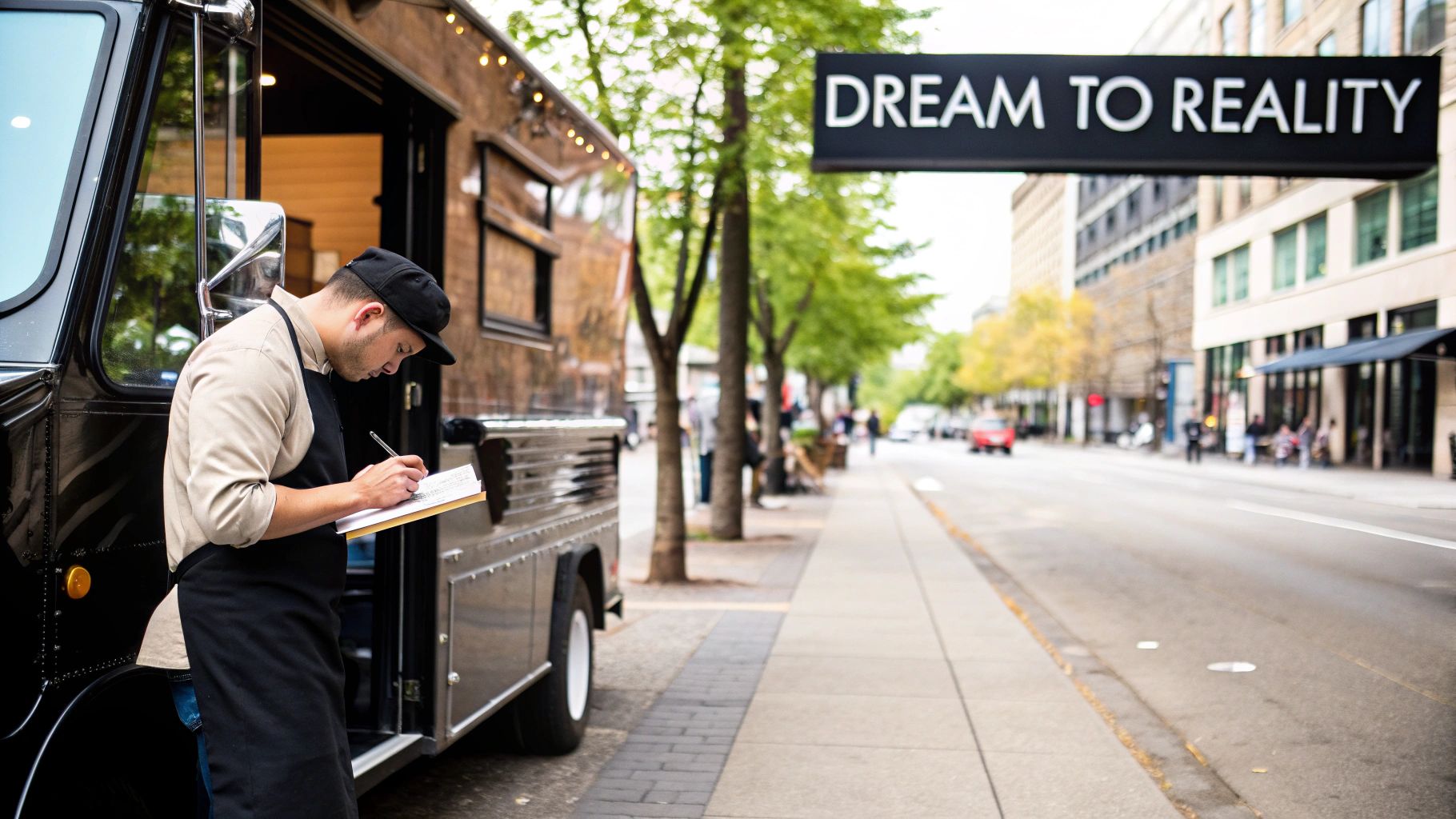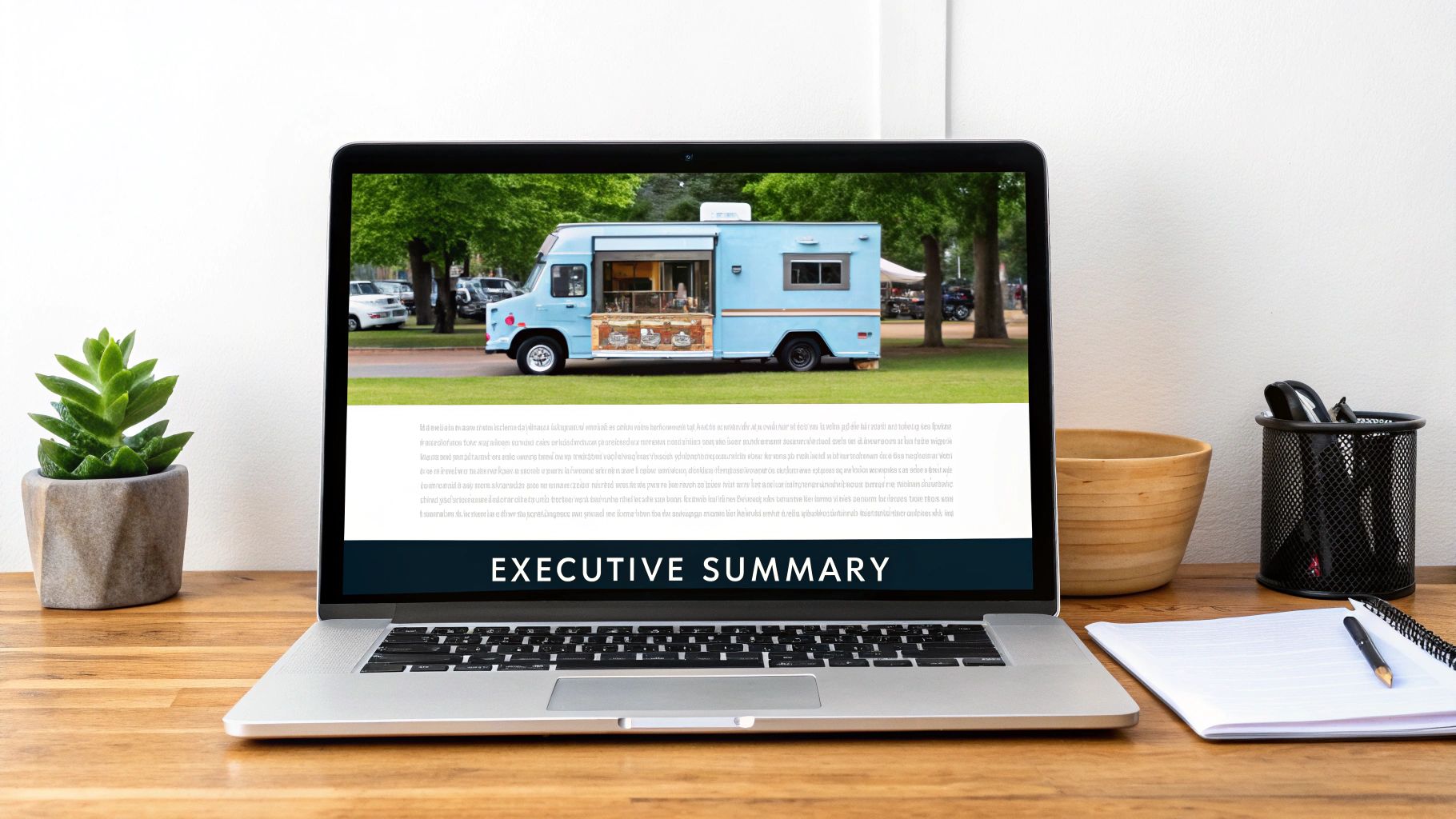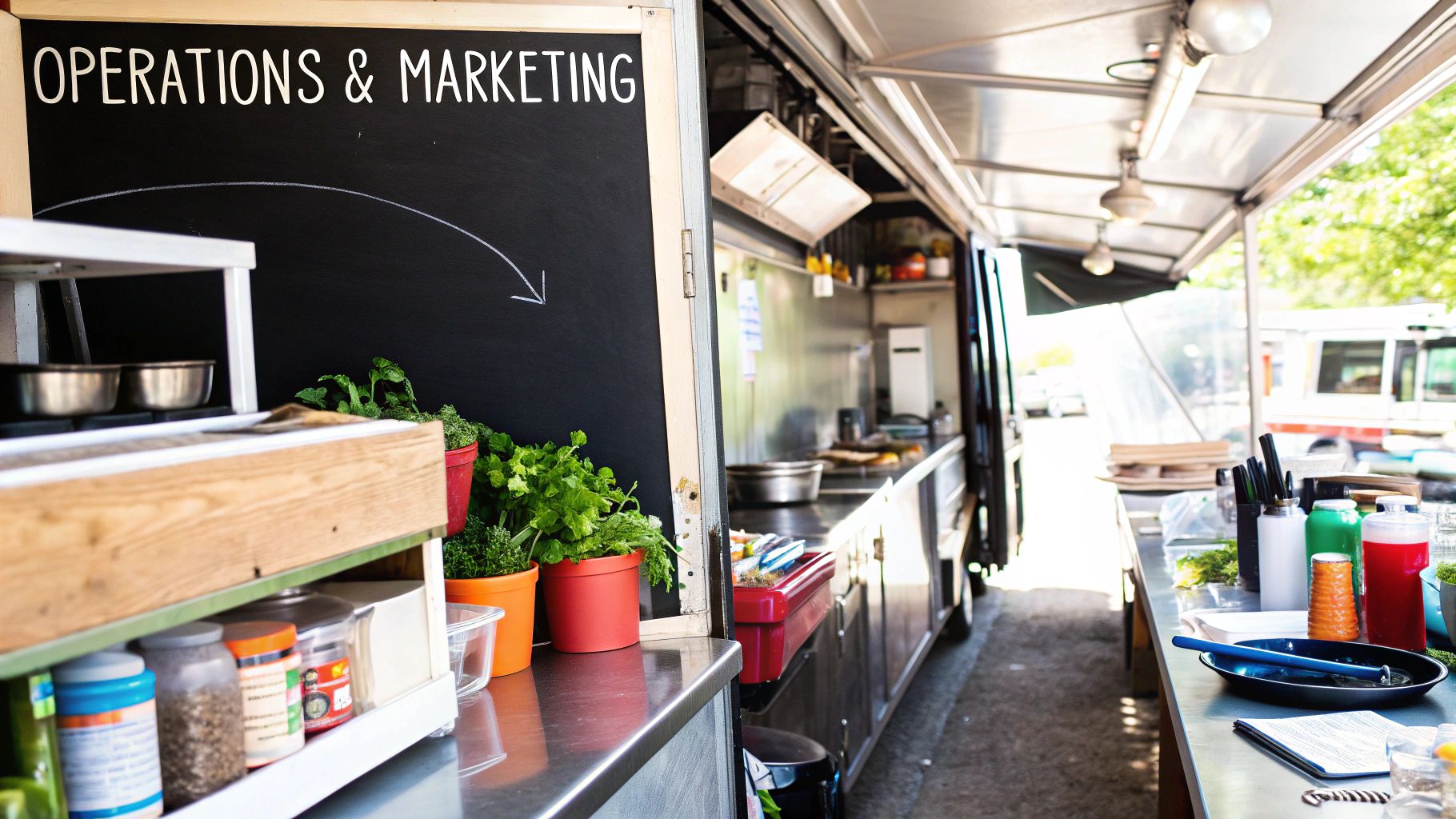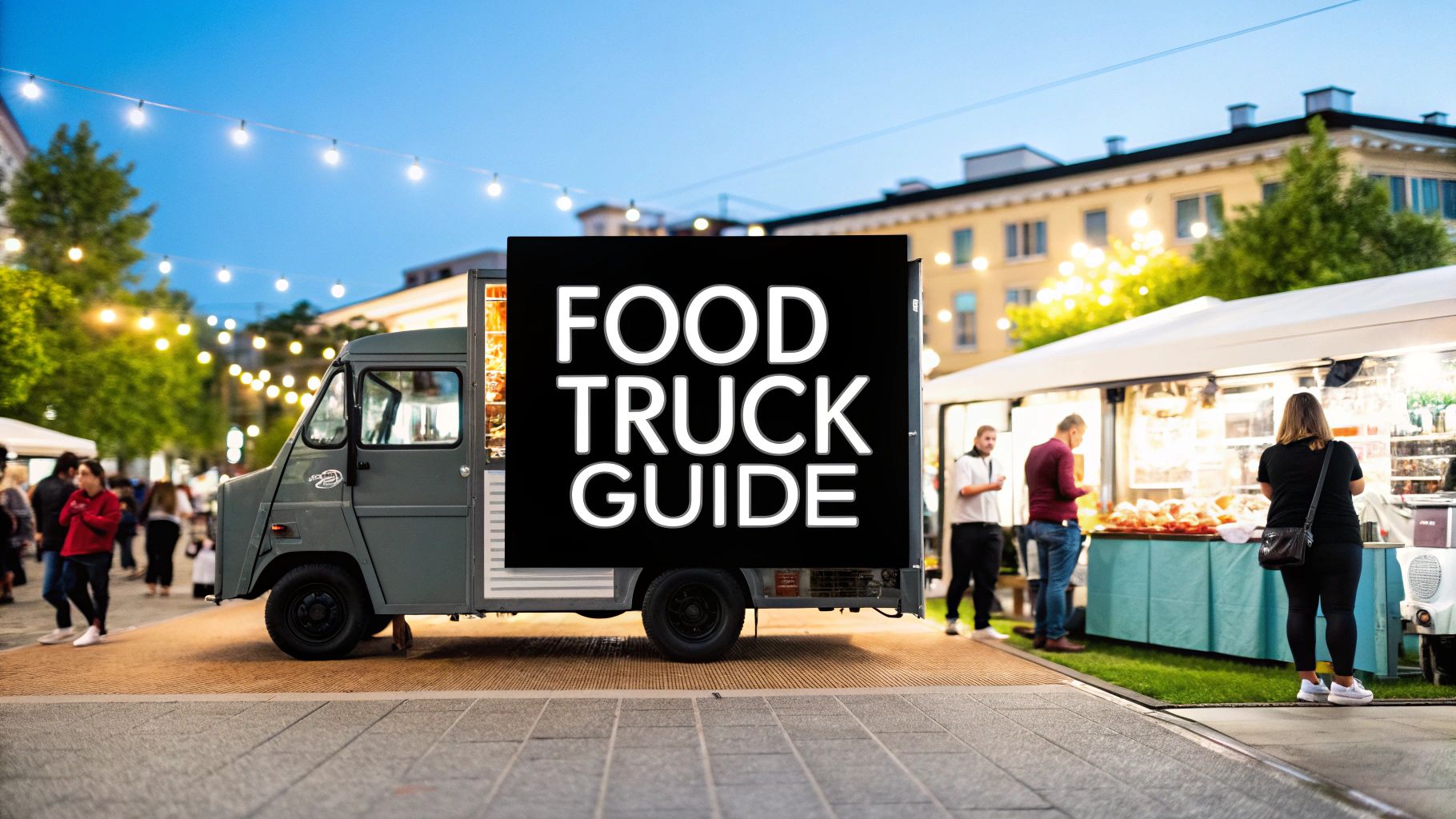Turning your passion for food into a real-life, profitable food truck isn't just about crafting the perfect menu. It hinges on having a solid, strategic business plan to guide your small business. Think of your business plan as the operational roadmap that takes you from a brilliant idea to daily success and, eventually, long-term growth. It's the one document that will help you, the entrepreneur, secure funding and make smart decisions when it counts.
From Kitchen Dream To Business Reality

The spark for most food trucks is a singular, powerful vision—maybe it’s serving your grandmother’s authentic tacos, creating mind-blowing gourmet grilled cheese, or brewing specialty coffee for the morning rush. That culinary creativity is the heart of your venture, no doubt. But the business plan? That’s the backbone holding it all together. It’s what turns your abstract ideas into a concrete, bankable document that proves your small business concept is not just delicious but genuinely viable.
This guide is designed for the small entrepreneur. We'll walk through each critical section of a food truck business plan piece by piece, using a practical, real-world sample as our guide. This approach will show you exactly how to:
- Pinpoint your unique brand and menu concept.
- Dig into your target market and size up the local competition.
- Map out your day-to-day operations and marketing plan.
- Build realistic financial projections that prove your small business can be profitable.
Why Your Business Plan Is Non-Negotiable
For any aspiring small business owner, a business plan is your most powerful tool. It forces you to think through every single detail of your mobile eatery before you sink a significant amount of time and money into it. This is where you get to stress-test your ideas, nail down your startup costs, and map out a clear path to success.
The food truck industry is absolutely booming, which means there's a ton of opportunity but also a lot of competition. The global food truck market is projected to skyrocket from $5.8 billion in 2025 to $10.9 billion in 2035, all thanks to people wanting convenient, high-quality, and interesting food on the go. To carve out your slice of this expanding market, your small business needs a plan that makes you stand out and shows you have a firm grip on the financial side of things.
A food truck business plan isn't just a document for investors or loan officers; it's for you. It’s your private playbook, your financial reality check, and the very first major step toward turning a culinary dream into a sustainable small business.
Navigating The Road Ahead
Before we dive into the sample plan, it's helpful to see the big picture. Your business plan is made up of several key sections, each with a distinct purpose. Here’s a quick breakdown of what you'll be building for your small business.
Core Elements of Your Food Truck Business Plan
| Section | Core Purpose |
|---|---|
| Executive Summary | A compelling, high-level overview of your entire business. |
| Company Description | Explains who you are, your mission, and your legal structure. |
| Market Analysis | Proves you understand your industry, target customers, and competitors. |
| Organization & Management | Details your team and who is responsible for what. |
| Products & Services | Showcases your menu and what makes it unique. |
| Marketing & Sales Strategy | Outlines how you'll attract and retain customers in your marketing plan. |
| Financial Projections | Provides the numbers—startup costs, revenue forecasts, and profitability. |
Throughout this guide, we will break down each of these components, from the executive summary all the way to the financial statements. By following along with our sample, you'll gain the confidence and clarity you need to write your own business plan. For another great resource, check out a comprehensive guide to building your food truck business plan. This document is about to become your blueprint for building a thriving mobile food empire.
Nailing Your Executive Summary and Company Identity

This is it—your thirty-second pitch on paper. The executive summary is the very first thing anyone reads, and for a busy lender, it's often the only thing they'll read if it doesn't grab them. It's your one shot to convince a potential investor, lender, or partner that your food truck dream isn't just a dream; it's a solid, viable business worth their time.
Here's a pro-tip that saves every entrepreneur a lot of headaches: write this section last. I know, it feels weird since it goes at the front, but trust me. Only after you've agonized over menu costs, mapped out your competition, and built your financial projections will you have the clarity needed to distill it all into a powerful, concise story.
For a small business owner, this is where you blend your passion with a professional business model. It’s not a boring report; it's the heart of your venture, summarized.
What Makes an Executive Summary Work?
A great summary is a highlight reel. It needs to quickly and clearly answer the most critical questions buzzing in a reader's mind.
Think about hitting these four key points:
- Your Mission: Get right to it. What is your food truck, and what does it do? For our example, "Urban Tacos," the mission is "to serve authentic, gourmet street tacos with locally sourced ingredients to downtown professionals and festival-goers."
- The Problem You Solve: Briefly point out a gap in the market you're about to fill. For example, "While the city has plenty of food trucks, there's a real lack of high-quality, quick-service Mexican food that also caters to the vegan community."
- What Makes You Different: This is your secret sauce. Is it your grandmother's legendary salsa recipe? A fanatical commitment to farm-to-truck ingredients? Your business model might be built on a state-of-the-art, eco-friendly truck. Whatever it is, mention it here.
- The Bottom Line: Don't be shy with the numbers. State your total startup cost, how much funding you need, and a key projection, like hitting $250,000 in first-year revenue or breaking even in nine months. It shows you’ve done the math for your business plan.
A killer executive summary doesn’t just inform; it makes the reader eager to turn the page. It's confident, clear, and gives just enough detail to prove you're a serious entrepreneur without drowning them in data.
Defining Who You Are: The Company Description
Right after the summary, the Company Description is where you lay the foundation. If the summary was the sizzle, this is the steak. It's where you get specific about your brand's personality, your legal structure, and your vision for the future—all critical for building a small business that lasts.
Keep this part direct and professional. Start with your official business name—for our example, we'll call it Urban Tacos LLC. Choosing a structure like an LLC (Limited Liability Company) is a smart move for most food truck entrepreneurs because it separates your business liabilities from your personal assets. It's an essential layer of protection.
Next, bring your brand to life. What's the vibe? Are you edgy and urban? Rustic and wholesome? Fun and a little quirky? This personality will drive everything from the design of your truck's wrap to the tone of your Instagram posts. For Urban Tacos, the identity is "modern, fresh, and community-focused."
Finally, lay out some concrete goals. These shouldn't be vague hopes; they need to be specific, measurable objectives for your small business's first couple of years.
Urban Tacos: Goals for Year 1-2
- Lock Down Prime Spots: Secure three high-traffic weekday lunch locations and get approved as a preferred vendor for at least four major local festivals.
- Get in the Black: Hit our break-even point within the first nine months of operation.
- Build a Tribe: Grow our social media to over 5,000 engaged local followers and launch a customer loyalty program by the end of year one.
By starting your business plan with a sharp executive summary and a clear company identity, you immediately establish both your passion for the food and your serious approach to the business.
Getting to Know Your Local Market and Competition
Even the most incredible menu is just a dream without hungry customers lining up to pay for it. This part of your business plan is where you prove that a real, profitable market for your food truck actually exists. It’s all about swapping assumptions for hard evidence to make sure your truck is in the right place, at the right time, serving the right people.
This isn’t about guesswork; it's about doing your homework. The goal is to paint a crystal-clear picture of who you'll be serving and who you'll be competing against. For a small business owner, this analysis is your best defense against risk and your secret weapon for finding opportunities everyone else has missed.
Finding Your Tribe: Your Target Market
First things first: you need to know exactly who you're selling to. And "everyone" is not an answer. A focused approach means you can tailor everything—your menu, your prices, your marketing plan—directly to the people most likely to become your biggest fans.
A great way for a small entrepreneur to start is by creating a few customer "personas." Are you trying to reach:
- The Downtown Lunch Crowd: Think office workers and professionals who need a quick, quality meal between 11 AM and 2 PM. They care about speed, convenience, and fresh, tasty ingredients.
- Weekend Festival-Goers: These are families and young adults at community events, concerts, or farmers' markets. They're on the hunt for unique, shareable, and Instagram-worthy food experiences.
- The Late-Night Bar Scene: A younger crowd looking for satisfying, carb-heavy eats after a night out, usually between 10 PM and 2 AM.
- Suburban Families: Folks at local parks, kids' soccer tournaments, or neighborhood gatherings who want easy, family-friendly food options that won't break the bank.
Once you’ve zeroed in on your primary audience, it's time to dig into the data. Look up local demographic information for the areas you plan to operate in. What’s the average age, income level, and lifestyle like? This will either confirm your gut feelings or tell you to pivot. For example, a gourmet vegan business model might be a huge hit near a university campus but would likely flop in an industrial park.
Knowing your ideal customer is the bedrock of your entire business model. It tells you where to park, what hours to keep, how to price your menu, and even how to design your truck.
Sizing Up the Competition
Let's be real—you won't be the only truck on the street. A solid competitive analysis helps you understand who you're up against and, more importantly, how you can stand out from the crowd. This isn't about stealing ideas; it's about carving out your own unique space in the market.
Start by making a list of every competitor in your target zones. This includes direct competitors (other food trucks, especially those with similar food) and indirect competitors (nearby fast-casual spots, delis, and cafes).
For each key competitor, put on your detective hat and analyze these points:
- Menu and Pricing: What are they serving, and what are they charging? Look for the gaps. If every other taco truck serves the same three basic meats, maybe ‘Urban Tacos’ can win over customers with creative vegetarian options or premium grilled fish tacos.
- Locations and Hours: Where do they set up shop and when? Follow their social media or even just drive by for a week. A consistent schedule can reveal high-traffic spots, while a more random one might show underserved areas or times.
- Branding and Vibe: What does their truck look like? What’s their brand's personality? A competitor's dated design or weak social media presence is a golden opportunity for your small business to look fresh, modern, and more appealing.
- Online Presence: Dive into their website, social media feeds, and Yelp reviews. What do customers rave about? What are the common complaints? These reviews are a goldmine of intel on everything from service speed to food quality, highlighting customer pain points you can solve.
The food truck scene has exploded, which means tons of opportunity but also more competition. In the United States alone, the industry's revenue is on track to hit $2.8 billion in 2025, growing at a blistering 13.2% each year for the past five years. The good news? The market is highly fragmented, with no single giant dominating the scene. This is a perfect environment for a new small business to jump in and make a name for itself. For a deeper dive, you can check out market insights from IBISWorld.
By putting in the work to analyze the market and your competition, you move from just having a cool idea to having a smart, strategic business. For our example, ‘Urban Tacos,’ this research might uncover that no other truck stays open past 10 PM in the downtown bar district—an immediate, profitable niche for their business model. This is the kind of insight that turns a sample business plan into a real recipe for success. These same principles apply to other food ventures, too. You can see how market analysis adapts by looking at our guide for creating a solid catering business plan.
Designing Your Operations and Marketing Plan

This is where the rubber meets the road. A killer menu and a solid grasp of your market are great starting points, but they fall apart if you can't actually serve your customers efficiently, day in and day out. For any new food truck entrepreneur, the operations and marketing plan sections are your engine and your megaphone. One keeps you running smoothly, and the other makes sure people know you exist.
Think of this part of your business plan as proving you've thought through the daily grind. It’s the nitty-gritty that shows potential investors—and yourself—that you have a real business, not just a passion project.
Mapping Out Your Daily Operations
Your operations plan is your daily playbook. It covers every single step, from how you get your ingredients to how you clean up at the end of the night. A well-oiled operational plan is what ensures every customer gets the same great food, helps you keep costs in check, and keeps the health inspector happy. In a food truck, this isn't just about cooking; it’s a logistical puzzle in a very small box.
First things first: your suppliers. Where is all your food coming from? In our "Urban Tacos" example, the business plan would name the specific local farm for cilantro and produce and the regional distributor for our high-quality carne asada and tortillas. This shows you’ve not only sourced for quality but also for reliable delivery and fair pricing.
Next, you need to detail your commissary kitchen. Nearly all health departments require food trucks to prep, clean, and store food in a licensed commercial kitchen. Your plan needs to state which commissary you've chosen, how much it costs, and what your routine looks like. For instance, you might prep from 6 AM to 9 AM before driving to your first lunch spot.
Finally, you need the right tools for the job. What Point of Sale (POS) system are you going to use? Don't skimp here. A modern, tablet-based system like Square or Toast is essential for a small business. It easily takes credit cards, Apple Pay, and everything in between. More importantly, it gives you priceless data on what's selling and when you're busiest.
Building Your Marketing Engine
Your truck is basically a billboard on wheels, but you can't just park on a corner and hope for the best. A smart marketing plan is how you actively find and keep your customers. In the crowded food truck world, just sitting back and waiting is a recipe for disaster. You have to create a buzz and build a loyal following.
The design of your truck's wrap is your single most powerful marketing tool. It has to be bold, look professional, and tell people what your small business is all about in a single glance. For "Urban Tacos," the design would be modern and eye-catching, with a clean logo and social media handles that are easy to read from the sidewalk.
Social media is the heartbeat of any modern food truck's marketing plan. Your business plan should get specific about which platforms you'll focus on (Instagram and Facebook are non-negotiable) and what your content will be. That means:
- Daily Location Updates: Every single morning, without fail, post where you'll be and what your hours are. Nothing makes a potential customer angrier than having to hunt you down.
- Mouth-Watering Food Photos: Make your food look as good as it tastes. Good lighting is everything.
- Behind-the-Scenes Peeks: Show off your prep, introduce your team, and let people feel like they're part of your small business journey.
- Real Community Engagement: Reply to comments, share photos customers tag you in, and run fun promotions for your followers.
Your marketing plan isn't a one-and-done deal. It's an ongoing conversation that turns a curious passerby into a regular who goes out of their way to find you.
Beyond social media, your marketing plan needs to show how you'll plug into the local scene. This is where small businesses can really outshine the big chains.
Local Engagement Strategies for Urban Tacos
| Strategy | Description | Goal |
|---|---|---|
| Event Partnerships | Systematically apply to be a food vendor at local music festivals, farmers' markets, and art walks. | Get in front of huge, targeted crowds and drive massive sales in a short period. |
| Corporate Catering | Create and market a specific catering menu to nearby office parks for company lunches and team events. | Lock in a reliable, high-margin revenue stream that complements daily street service. |
| Brewery Collaborations | Team up with local craft breweries for weekend pop-ups. They provide the beer and the crowd; you provide the food. | Tap into an existing customer base and build valuable relationships with other local businesses. |
By laying out both your operational logistics and your marketing game plan, your food truck business plan transforms into a document that inspires confidence. It proves you not only have a delicious idea but also a realistic strategy to bring it to life and make it thrive.
Projecting Your Startup Costs And Profitability

Alright, let's talk about the numbers. A killer concept and mouth-watering recipes are the heart of your food truck, but your financials are the engine that keeps it running. This is where you swap your chef's hat for a bookkeeper's visor and prove that your passion project can actually be a profitable small business.
For a lot of first-time entrepreneurs, this is the most daunting part of the whole process. But don't let the spreadsheets scare you. Think of it as a puzzle: you're figuring out what it costs to get started, what you can realistically earn, and how those two pieces fit together. This financial roadmap isn't just for you; it's the first thing any potential lender or investor will want to see in your business plan.
Breaking Down Your Startup Costs
Before you serve your first customer, you have to spend some cash. The first job here is to create a painfully detailed list of every single one-time expense needed to get your service window open. This is where so many new small businesses stumble—they forget something crucial, and it blows their budget.
Be brutally honest with yourself. It's always better to overestimate than to get caught short. In fact, every savvy entrepreneur should add a 10-15% contingency fund on top of the total for those "uh-oh" moments that inevitably pop up.
To give you a clearer picture, here’s a look at the major expenses you'll be facing.
Sample Startup Cost Breakdown For A Food Truck
This table outlines the typical one-time expenses a small entrepreneur will encounter when launching a food truck. Use it as a starting point to build your own detailed budget.
| Expense Category | Estimated Cost Range |
|---|---|
| The Truck | $30,000 – $80,000+ |
| Kitchen Equipment | $10,000 – $25,000 |
| Initial Inventory | $2,000 – $4,000 |
| Licenses & Permits | $1,000 – $5,000 |
| POS System | $500 – $1,500 |
| Insurance | $2,000 – $4,000 (Initial deposit) |
| Marketing & Branding | $1,500 – $3,000 |
| Contingency Fund | $5,000 – $10,000 |
As you can see, the numbers can vary wildly. A bare-bones, DIY setup might get you on the road for around $50,000, while a brand-new, fully-equipped truck can easily top $150,000. Having this level of detail shows lenders you’ve done your homework.
Crafting Your Financial Projections
Once you know what it costs to open, it's time to predict the future. Your financial projections are built on three core documents: the Profit & Loss Statement, the Cash Flow Statement, and the Break-Even Analysis. Each one answers a simple but vital question about your small business's health.
And speaking of costs, don't forget insurance. Since your entire business is on wheels, specialized coverage is non-negotiable. It’s worth taking the time to understand what goes into a good Commercial Auto Insurance policy, as this will be a significant recurring expense.
Profit & Loss (P&L) Statement
Your P&L projects your performance, usually over the first 12 months, and answers one big question: "Are we actually making money?" The formula is straightforward: Revenue – Cost of Goods Sold (COGS) – Operating Expenses = Net Profit.
- Revenue: How much do you realistically expect to sell? For an imaginary truck like "Urban Tacos," you might estimate selling to 50 people a day at an average of $15 per order, five days a week.
- COGS: This is the cost of your ingredients. For most food trucks, you want to keep your food cost between 28-35% of your menu price.
- Operating Expenses: These are your fixed monthly bills—fuel, commissary kitchen rent, insurance premiums, loan payments, marketing, and, yes, your own salary.
Cash Flow Statement
This one answers a different, but equally important, question: "Do we have enough cash to pay the bills?" Profit and cash are two different things. You can be profitable on paper but go out of business because you don't have enough cash in the bank to cover expenses during a slow month. This statement tracks the actual money coming in and going out, which is critical for any small business to survive seasonal dips.
Break-Even Analysis
Finally, this analysis tells you: "How much do we need to sell just to cover our costs?" This is your survival number. It calculates the exact amount of sales you need each day or week to hit zero profit. Knowing your break-even point gives you a clear, tangible sales target and helps you price your menu intelligently. A solid feasibility study done early on can provide the foundational data to make this analysis much more accurate.
These financial projections are more than just homework for the bank. They are the blueprint you'll use to build a food truck business that doesn't just survive, but truly thrives.
Common Questions About Food Truck Business Plans
Even with the best guide, you're bound to hit a few roadblocks when writing your business plan. It’s completely normal. Let's tackle some of the most common questions I hear from aspiring food truck entrepreneurs so you can get unstuck and move forward with confidence.
Getting these details right is what transforms a great idea on paper into a small business that investors and lenders will actually want to fund.
How Detailed Do My Financial Projections Really Need To Be?
There’s no way to sugarcoat this: they need to be incredibly detailed. Vague or pie-in-the-sky numbers are the fastest way to get your business plan rejected. Think of your financials as the backbone of your entire proposal—they prove you’ve done the hard work and have a realistic shot at making money.
A solid financial section should always include:
- A full startup cost breakdown: Everything from the truck itself to spatulas, permits, and your first big grocery run.
- 12-month profit and loss projections: This is where you map out your expected revenue against all your monthly operating costs.
- A cash flow statement: This is crucial. It shows you'll have enough actual cash in the bank to pay your bills, especially during those inevitable slow seasons.
- A break-even analysis: You need to know the exact dollar amount in sales you must hit just to cover your costs.
The real key here is to justify your numbers. Don't just pull figures out of thin air. Show your work—how you estimated your average daily sales, what your target check average is, and precisely how you calculated your food cost percentages. This is what builds trust and credibility for you as an entrepreneur.
What Are The Biggest Mistakes To Avoid In My Plan?
The classic rookie mistakes are almost always underestimating costs, having a fuzzy idea of who your customer is, and completely overlooking local laws and regulations. It’s easy for an entrepreneur to get excited about perfecting a killer taco recipe and forget about the less sexy, but vital, business details.
A strong business plan answers the tough questions head-on: Where will you legally park? What are your specific insurance needs? How will you manage inventory in such a small space? Addressing these proves your concept is grounded in reality, not just wishful thinking.
Another huge pitfall is a weak marketing plan. Great food is a start, but it's not a strategy. You need a concrete marketing plan for how you’re going to get people to your truck’s window on day one, and how you’ll keep them coming back. For more insights on common business planning questions, you can explore our comprehensive small business FAQ page.
Do I Need To Include A Full Menu?
Yes, you absolutely do. A sample menu, complete with realistic pricing, is a non-negotiable part of your business plan. It’s the most concrete part of your vision, showing investors your brand, your business model, and your financial potential all at once.
Your menu is directly tied to nearly every number in your financial projections, from the cost of goods sold (COGS) to the average amount you'll make from each customer.
For every dish, you should have a target food cost percentage calculated. In this industry, you’re typically aiming for 28-35%. Of course, your menu will change over time, but the one in your business plan must be a well-researched, realistic snapshot of what you’ll be serving when you open. It’s where your culinary passion meets your financial reality as a small business owner.
Ready to stop guessing and start building? GrowthGrid uses advanced AI to help you create a professional, comprehensive business plan in under 15 minutes. Answer a few simple questions, and our platform will generate everything you need—from financial projections to marketing strategies—so you can launch your food truck with confidence. Build your winning plan today at https://growth-grid.ai.
